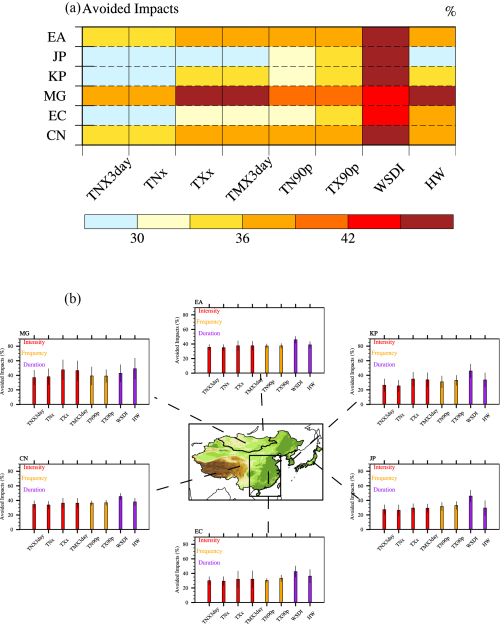0.5°C Less Warming Avoids the Increases in Extreme Heat Events over East Asia
Date:2018-02-11
Since the industrial revolution, with the increase of greenhouse gas emissions caused by the burning of fossil fuels, the average global temperature has gradually risen and the frequency and intensity of occurrence of extreme high temperature events have also been increasing. The "Paris Agreement" adopted by the United Nation Framework Convention on Climate Change (UNFCCC) Conference of the Parties in December 2015 officially included the "2°C Global Temperature Target" in the conference results and pursued efforts "to limit the level of global temperature rise to 1.5°C above pre-industrial levels".
At 1.5/2°C temperature warming level, how the global and regional climate will change, is a matter of public concern and relates to the decisions of policies, guidelines and measures on mitigation and adaption of future climate change. Accurate answers to this question are subject to data constraints, as neither of the available projection datasets under future climate change scenarios is designed for a 1.5/2°C temperature warming levels, making it difficult to predict based on existing climate change projection results to accurately estimate the differences in equilibrium climate responses at two temperature warming levels.
Recently, LI Donghuan, a doctoral student from the Institute of Atmospheric Physics, Chinese Academy of Sciences, along with her mentors Prof. ZHOU Tianjun and associate Prof. ZOU Liwei, used the long-term impact-relevant coupled climate model data available for stabilization pathways at 1.5°C and 2°C warming levels, which was released by the National Center for Atmospheric Research (NCAR), to investigate the change of extreme high temperature events over East Asia in 1.5°C and 2°C warmer futures. Based on the analysis of changes in multiple indices that characterize the intensity, frequency and duration of extreme high temperature events, they show that the magnitude of warming in East Asia is approximately 0.2°C higher than the global mean in both warming scenarios. Most populous subregions, including eastern China, the Korean Peninsula and Japan, will see more intense, more frequent and longer lasting extreme temperature events under 1.5°C and 2°C warming. The 0.5°C lower warming will help avoid 35%-46% of the increases in extreme high-temperature events in terms of intensity, frequency and duration in East Asia with maximal avoidance values (37%-49%) occurring in Mongolia. This means that it is beneficial for East Asia to limit the warming target to 1.5°C rather than 2°C.

(a) Avoided extreme high-temperature events (units: %) over East Asia and its subregions in 1.5°C compared with 2°C warmer future. “EA” denotes East Asia, “JP” denotes Japan islands, “KP” denotes Korean Peninsula, “MG” denotes Mongolia, “EC” denotes “East China”, and “CN” denotes China. (b) Same as subplot (a) but shows detailed information. The black vertical lines over the bars show the range of two standard deviations. The red bars represent the indices defined by intensity, the orange bars represent the indices defined by frequency, and the purple bars represent the indices defined by duration. TNX3day is the highest 3 day mean minimum temperature in a year, TMX3day is 3 day warm day event, TNx is annual maximal daily minimum temperatures, TXx is annual maximal daily maximum temperatures, TN90p is warm nights, TX90p is warm days, WSDI is warm spell duration indicator, HW represents the impacts of the longest period of hot days. (Image by IAP)
"In contrast to previous work on transient climate change under different temperature warming levels, we focus on equilibrium climate changes at two temperature warming levels and to quantify the changes of extreme high-temperature events over East Asia at 1.5°C and 2°C warming levels. Our results indicate that the 0.5°C less warming will help avoid 35%-46% of the increases in extreme high-temperature events in terms of intensity, frequency and duration in East Asia. As far as we know, this is the first published quantitative estimate of the equilibrium climate response over East Asia under the global 1.5 ° C and 2 ° C warming level, "says one of the authors Zou, "I hope the results are useful for the mitigation and adaption of climate change and the associated government decision-making. "
This work is recently published in Geophysical Research Letters.
Citation:
Li, D., T. Zhou, L. Zou, W. Zhang, and L. Zhang (2018), Extreme high-temperature events over East Asia in 1.5°C and 2°C warmer futures: Analysis of NCAR CESM low-warming experiments. Geophysical Research Letters, 45. https://doi.org/10.1002/2017GL076753.
